A New Approach for Environmental Risk Assessments of Living Modified Organisms in South Korea
Abstract
:1. Introduction
2. Materials and Methods
2.1. Construction for Transient Expression of the Vip3Aa Gene
2.2. Growing Plant Material for Agroinfiltration
2.3. Confirmation of the Vip3Aa Gene’s Introduction
2.4. Expression of Vip3Aa Protein
2.5. Insect Bioassays of the Vip3Aa Protein
2.6. Statistical Analysis
3. Results and Discussion
3.1. Domestic and International Regulatory Frameworks for LMOs
3.2. Approach to New Tools
3.3. Vip3Aa Protein Expression and Stability
3.4. Risk Assessment Using an Agroinfiltrated Plant
4. Conclusions
Supplementary Materials
Author Contributions
Funding
Institutional Review Board Statement
Informed Consent Statement
Data Availability Statement
Conflicts of Interest
References
- Prakash, D.; Verma, S.; Bhatia, R.; Tiwary, B.N. Risks and precautions of genetically modified organisms. Int. Sch. Res. Not. 2011, 2011, 369573. [Google Scholar] [CrossRef] [Green Version]
- Keiper, F.; Atanassova, A. Regulation of synthetic biology: Developments under the convention on biological diversity and its protocols. Front. Bioeng. Biotechnol. 2020, 8, 310. [Google Scholar] [CrossRef] [PubMed]
- Gupta, A.; Falkner, R. The influence of the Cartagena Protocol on biosafety: Comparing Mexico, China and South Africa. Glob. Environ. Politics 2006, 6, 23–55. [Google Scholar] [CrossRef]
- Kimani, V.; Gruère, G. Implications of import regulations and information requirements under the Cartagena Protocol on biosafety for GM commodities in Kenya. AgBioForum 2010, 13, 222–241. [Google Scholar]
- Entine, J.; Felipe, M.S.S.; Groenewald, J.H.; Kershen, D.L.; Lema, M.; McHughen, A.; Nepomuceno, A.L.; Ohsawa, R.; Ordonio, R.L.; Parrott, W.A.; et al. Regulatory approaches for genome edited agricultural plants in select countries and jurisdictions around the world. Transgenic Res. 2021, 30, 551–584. [Google Scholar] [CrossRef] [PubMed]
- Kim, T. The Regulatory Framework for Genetically Modified Agricultural Products in Korea; Food and Fertilizer Technology Center: Taipei, Taiwan, 2003; Volume 527, pp. 1–8. [Google Scholar]
- Jang, H.M. Status of policies relating biosafety. J. Plant Biotechnol. 2003, 5, 13–17. [Google Scholar]
- Kim, E.S. Technocratic precautionary principle: Korean risk governance of genetically modified organisms. New Genet. Soc. 2014, 33, 204–224. [Google Scholar] [CrossRef]
- Choi, W.K.; Jo, B.H.; Seol, M.A.; Eum, S.J.; Park, J.H.; Song, H.R. Presence of environmental risk assessments for LMOs in nature and future considerations based on new biotechnologies. Korean J. Int. Agric. 2014, 26, 297–302. [Google Scholar] [CrossRef]
- Nam, K.H.; Han, S.M. Seed germination of sunflower as a case study for the risk assessment and management of transgenic plants used for environmental remediation in South Korea. Sustainability 2020, 12, 10110. [Google Scholar] [CrossRef]
- Kim, I.R.; Lim, H.S.; Choi, W.K.; Kang, D.I.; Lee, S.Y.; Lee, J.R. Monitoring living modified canola using an efficient multiplex PCR assay in natural environments in South Korea. Appl. Sci. 2020, 10, 7721. [Google Scholar] [CrossRef]
- Lim, H.S.; Kim, I.R.; Lee, S.H.; Choi, W.K.; Yoon, Y.M.; Lee, J.R. Establishment and application of a monitoring strategy for living modified cotton in natural environments in South Korea. Appl. Sci. 2021, 11, 10259. [Google Scholar] [CrossRef]
- Kim, H.C.; Kim, H.M. Risk assessment of genetically modified organisms. J. Toxicol. Pub. Health 2003, 19, 1–12. [Google Scholar]
- Oh, S.W.; Kim, E.H.; Lee, S.Y.; Baek, D.Y.; Lee, S.G.; Kang, H.J.; Chung, Y.S.; Park, S.K.; Ryu, T.H. Compositional equivalence assessment of insectresistant genetically modified rice using multiple statistical analyses. GM Crops Food 2021, 12, 303–314. [Google Scholar] [CrossRef] [PubMed]
- R&D LMO Safety Management. Statute Book II, Cheongju, Korea. 2021. Available online: https://www.ip-korea.org/lib/pdf_view.php (accessed on 28 December 2021).
- Kim, S.B.; Kim, Y.H. Status and prospect of safety evaluation of genetically modified microorganism (GMM) for domestic and foreign food application. Food Sci. Ind. 2019, 52, 150–170. [Google Scholar] [CrossRef]
- Nakai, S.; Hoshikawa, K.; Shimono, A.; Ohsawa, R. Transportability of confined field trial data from cultivation to import countries for environmental risk assessment of genetically modified crops. Transgenic Res. 2015, 24, 929–944. [Google Scholar] [CrossRef] [Green Version]
- Garcia-Alonso, M.; Hendley, P.; Bigler, F.; Mayeregger, E.; Parker, R.; Rubinstein, C.; Satorre, E.; Solari, F.; McLean, M.A. Transportability of confined field trial data for environmental risk assessment of genetically engineered plants: A conceptual framework. Transgenic Res. 2014, 23, 1025–1041. [Google Scholar] [CrossRef] [Green Version]
- European Food Safety Authority (EFSA). Guidance on the environmental risk assessment of genetically modified plants. EFSA J. 2010, 8, 1879. [Google Scholar] [CrossRef]
- Gray, A. Problem formulation in environmental risk assessment for genetically modified crops: A practitioner’s approach. Collect. Biosaf. Rev. 2012, 6, 10–65. [Google Scholar]
- Bratlie, S.; Halvorsen, K.; Myskja, B.K.; Mellegård, H.; Bjorvatn, C.; Frost, P.; Heiene, G.; Hofmann, B.; Jensen, A.H.; Larsen, T.H.; et al. A novel governance framework for GMO. EMBO Rep. 2019, 20, e47812. [Google Scholar] [CrossRef]
- Hilbeck, A.; Meier, M.; Römbke, J.; Jänsch, S.; Teichmann, H.; Tappeser, B. Environmental risk assessment of genetically modified plants-concepts and controversies. Environ. Sci. Eur. 2011, 23, 13. [Google Scholar] [CrossRef] [Green Version]
- Garcia-Alonso, M.; Jacobs, E.; Raybould, A.; Nickson, T.E.; Sowig, P.; Willekens, H.; Van Der Kouwe, P.V.; Layton, R.; Amijee, F.; Fuentes, A.M.; et al. A tiered system for assessing the risk of genetically modified plants to non-target organisms. Environ. Biosaf. Res. 2006, 5, 57–65. [Google Scholar] [CrossRef] [PubMed] [Green Version]
- Goodin, M.M.; Zaitlin, D.; Naidu, R.A.; Lommel, S.A. Nicotiana benthamiana: Its history and future as a model for plant-pathogen interactions. MPMI 2008, 8, 1015–1026. [Google Scholar] [CrossRef] [PubMed] [Green Version]
- Zhang, Y.; Chen, M.; Siemiatkowska, B.; Toleco, M.R.; Jing, Y.; Strotmann, V.; Zhang, J.; Stahl, Y.; Fernie, A.R. A highly efficient Agrobacterium-mediated method for transient gene expression and functional studies in multiple plant species. Plant Commun. 2020, 1, 100028. [Google Scholar] [CrossRef] [PubMed]
- Lisong, M.; Lukasik, E.; Gawehns, F.; Takken, F.L.W. The use of agroinfiltration for transient expression of plant resistance and fungal effector proteins in Nicotiana benthamiana leaves. Methods Mol. Biol. 2012, 835, 61–74. [Google Scholar] [CrossRef]
- Chen, Z.; Zeng, M.; Song, B.; Hou, C.; Hu, D.; Li, X.; Wang, Z.; Fan, H.; Bi, L.; Liu, J.; et al. Dufulin activates HrBP1 to produce antiviral responses in tobacco. PLoS ONE 2012, 7, e37944. [Google Scholar] [CrossRef] [Green Version]
- Jung, Y.J.; Yoo, S.H.; Lee, J.R. Purification and risk assessment of Bacillus thuringiensis Vip3Aa protein against Apis mellifera. Korean J. Environ. Biol. 2019, 37, 585–591. [Google Scholar] [CrossRef]
- Hervet, V.A.D.; Laird, R.A.; Floate, K.D.A. Review of the McMorran diet for rearing Lepidoptera Species with addition of a further 39 species. J. Insect Sci. 2016, 15, 19. [Google Scholar] [CrossRef]
- Sivasupramaniam, S.; Head, G.P.; English, L.; Li, Y.J.; Vaughn, T.T. A global approach to resistance monitoring. J. Invertebr. Path. 2007, 95, 224–226. [Google Scholar] [CrossRef]
- Faure, J.D.; Napier, J.A. Europe’s first and last field trial of gene-edited plants? Elife 2018, 7, e42379. [Google Scholar] [CrossRef]
- Jung, H.J.; Han, T.H. Prospect of GMO monitering of LMO facilities with NGOs. Trends Agric. Life Sci. 2017, 54, 23–28. [Google Scholar] [CrossRef] [Green Version]
- Lee, B.K. A study on the establishment of isolation distances for environmental release of biotech crops. Korean J. Agric. Sci. 2017, 44, 188–195. [Google Scholar] [CrossRef]
- Komarova, T.V.; Baschieri, S.; Donini, M.; Marusic, C.; Benvenuto, E.; Dorokhov, Y.L. Transient expression systems for plant-derived biopharmaceuticals. Expert Rev. Vaccines 2010, 9, 859–876. [Google Scholar] [CrossRef] [PubMed]
- Naegeli, H.; Birch, A.N.; Casacuberta, J.; Schrijver, A.D.; Gralak, M.A.; Guerche, P.; Jones, H.; Manachini, B.; Messean, A.; Nielsen, E.E.; et al. Risk assessment of information on the subcombination Bt11 3 MIR162, related to the application of Syngenta (EFSA-GMO-DE-2009-66) for authorization of food and feed containing, consisting and produced from genetically modified maize Bt11 3 MIR162 3 MIR604 3 GA21. EFSA J. 2017, 15, 4745. [Google Scholar] [CrossRef] [Green Version]
- Syngenta Australia Pty Ltd. Risk Assessment and Risk Management Plan for DIR 157. Commercial Release of Cotton Genetically Modified for Insect Resistance (COT102); Australian Government Department of Health Office of the Gene Technology Regulator: Canberra, Australia, 2018.
- Bergamasco, V.B.; Mendes, D.R.P.; Fernandes, O.A.; Desidério, J.A.; Lemos, M.V.F. Bacillus thuringiensis Cry1Ia10 and Vip3Aa protein interactions and their toxicity in Spodoptera spp. (Lepidoptera). J. Invertebr. Pathol. 2013, 112, 152–158. [Google Scholar] [CrossRef] [Green Version]
- Khan, M.H.; Jander, G.; Mukhtar, Z.; Arshad, M.; Sarwar, M.; Asad, S. Comparison of in vitro and in planta toxicity of Vip3A for lepidopteran herbivores. J. Econ. Entomol. 2020, 113, 2959–2971. [Google Scholar] [CrossRef]
- Siegfried, B.D.; Spencer, T.; Crespo, A.L.; Storer, N.P.; Head, G.P.; Owens, E.D.; Guyer, D. Ten years of Bt resistance monitoring in the European corn borer: What we know, what we don’t know, and what we can do better. Am. Entomol. 2007, 53, 208–214. [Google Scholar] [CrossRef] [Green Version]
- Rangeshwaran, R.; Velavan, V.; Lewis, F.M.; Kumari, S.; Shylesha, A.N.; Mohan, M.; Kumar, S.; Sivakumar, G. Cloning, expression and bioassay of Vip3A protein from an indigenous Bacillus thuringiensis Isolate. J. Pure Appl. Microbiol. 2016, 10, 1533–1539. [Google Scholar]
- Chakroun, M.; Banyuls, N.; Bel, Y.; Escriche, B.; Ferré, J. Bacterial vegetative insecticidal proteins (Vip) from entomopathogenic bacteria. Microbiol. Mol. Biol. Rev. 2016, 80, 329–350. [Google Scholar] [CrossRef] [Green Version]
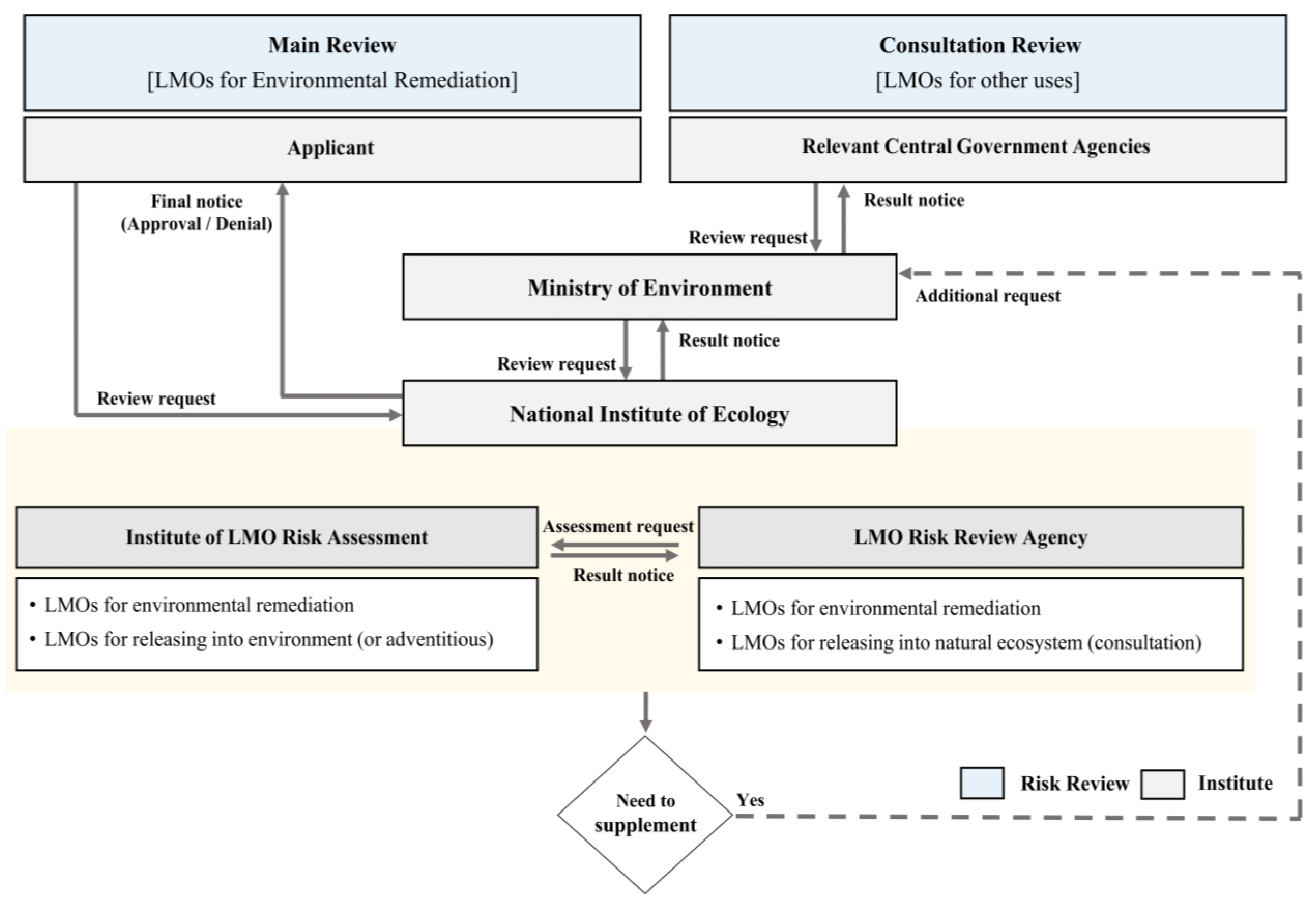
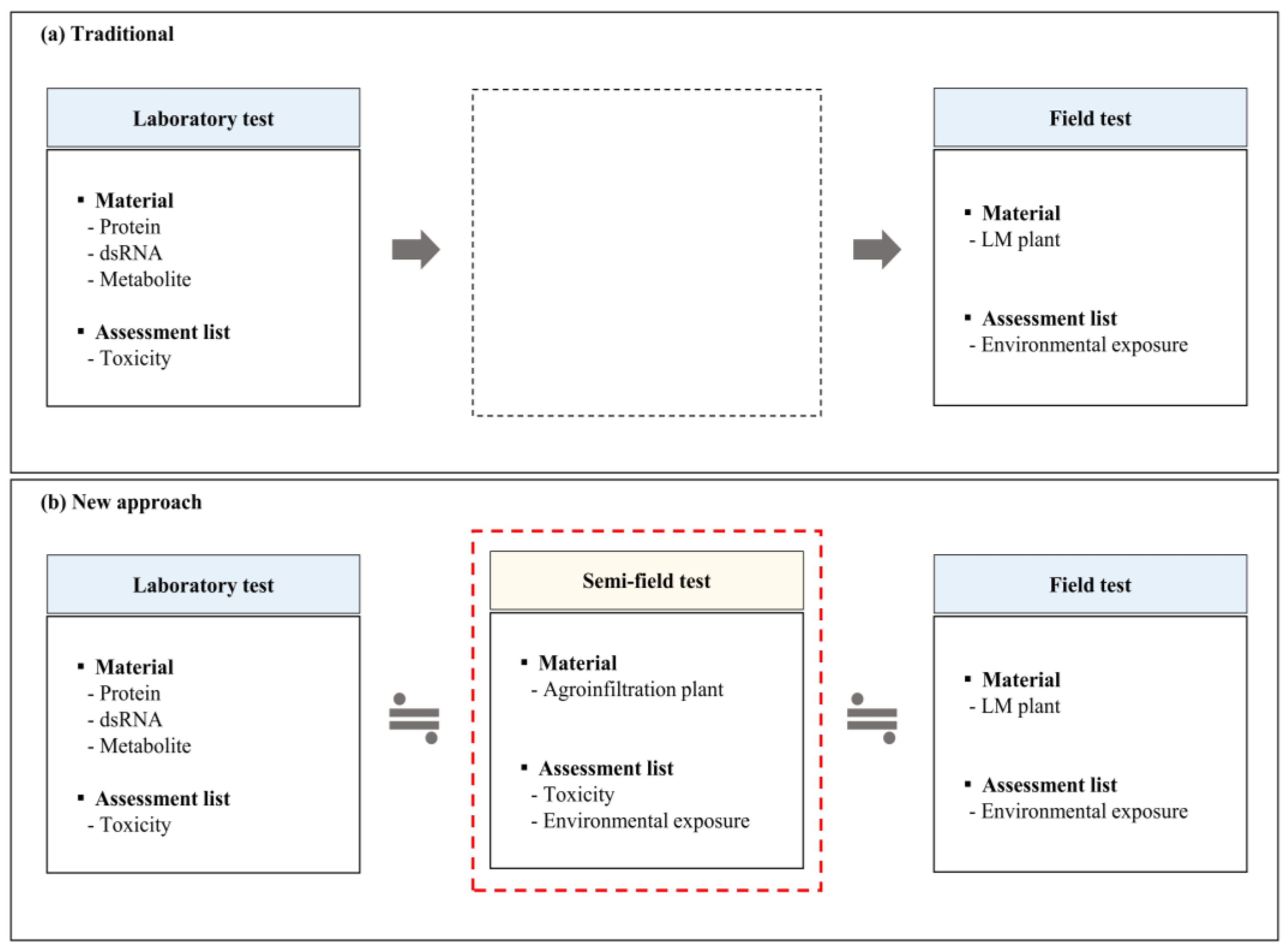
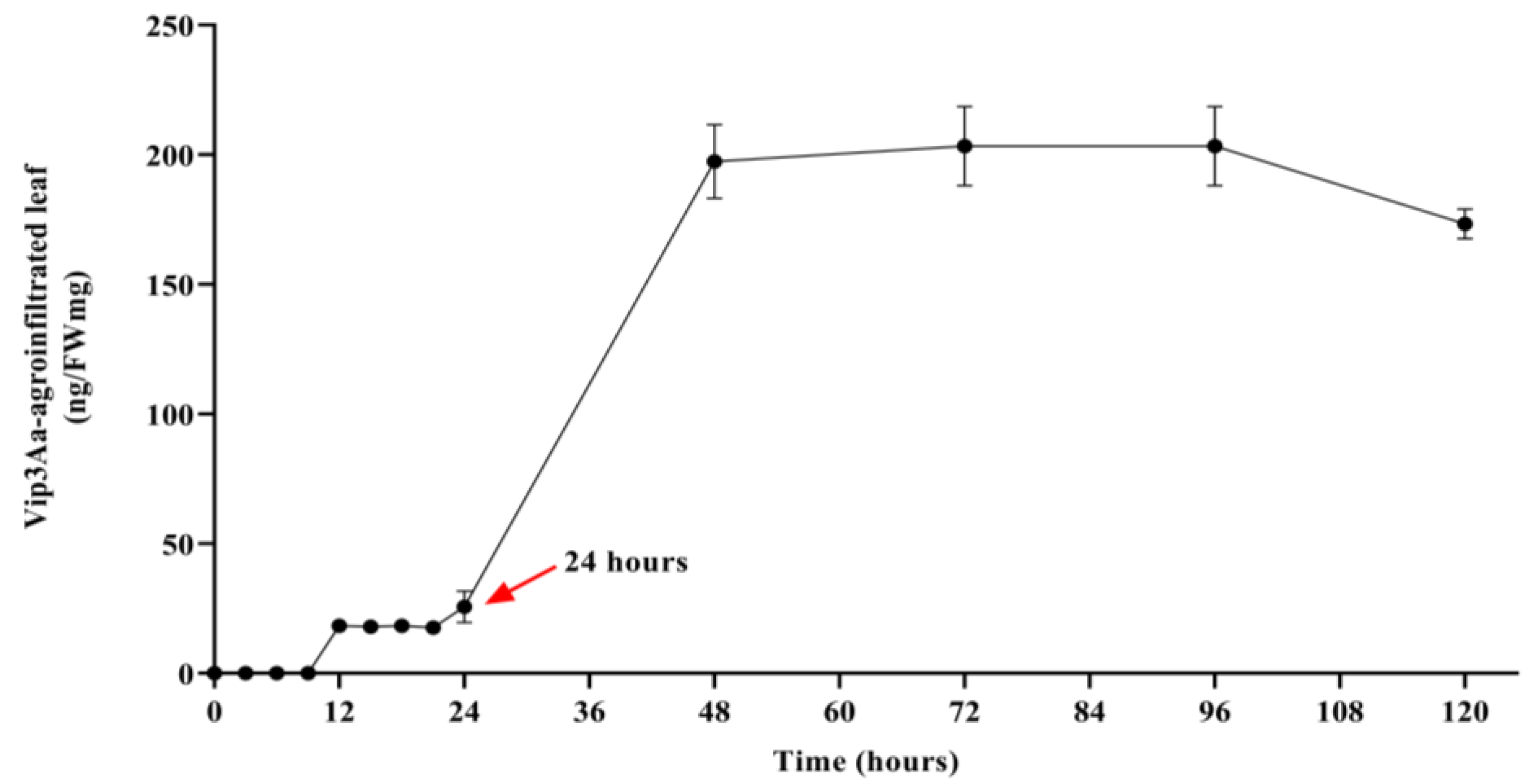
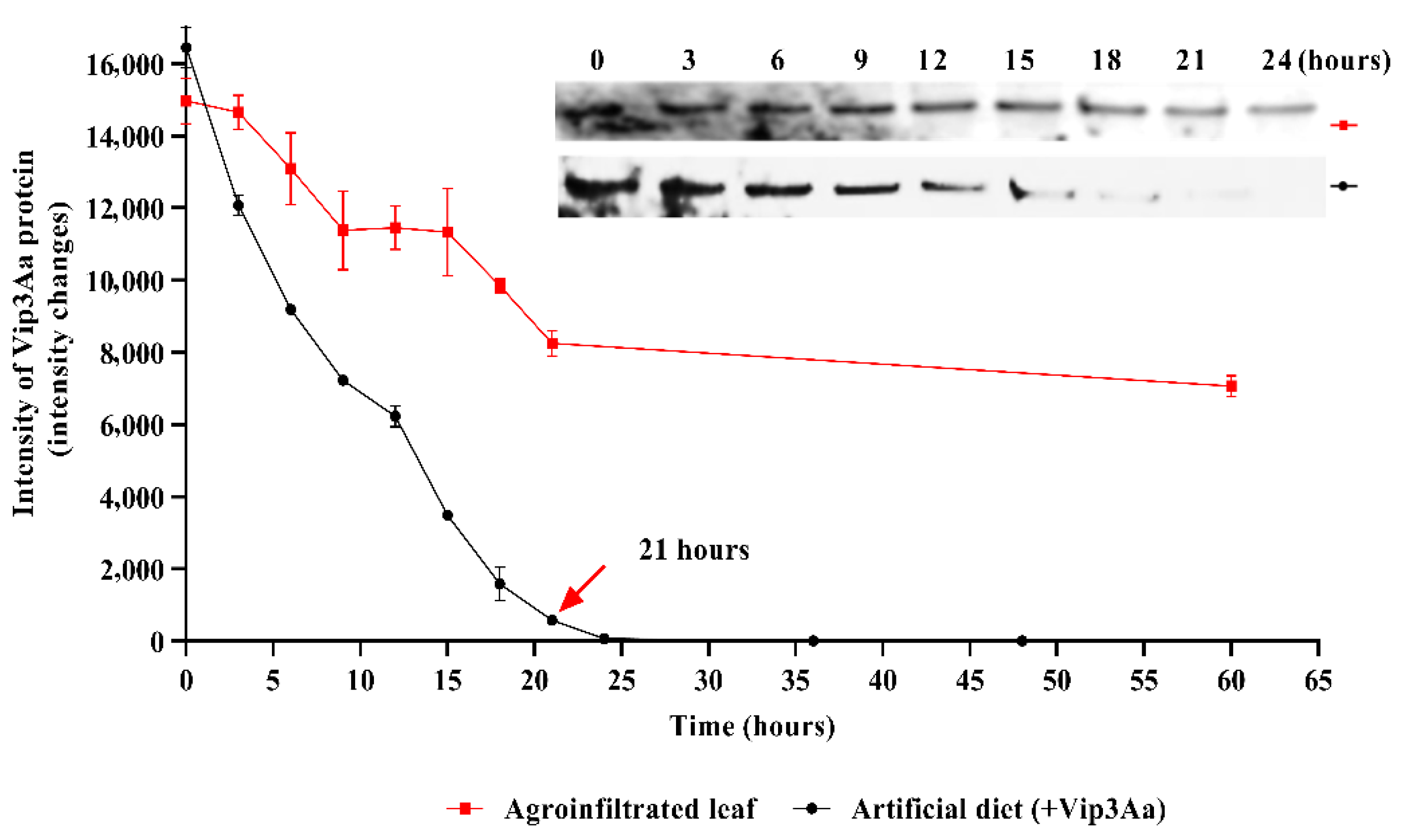
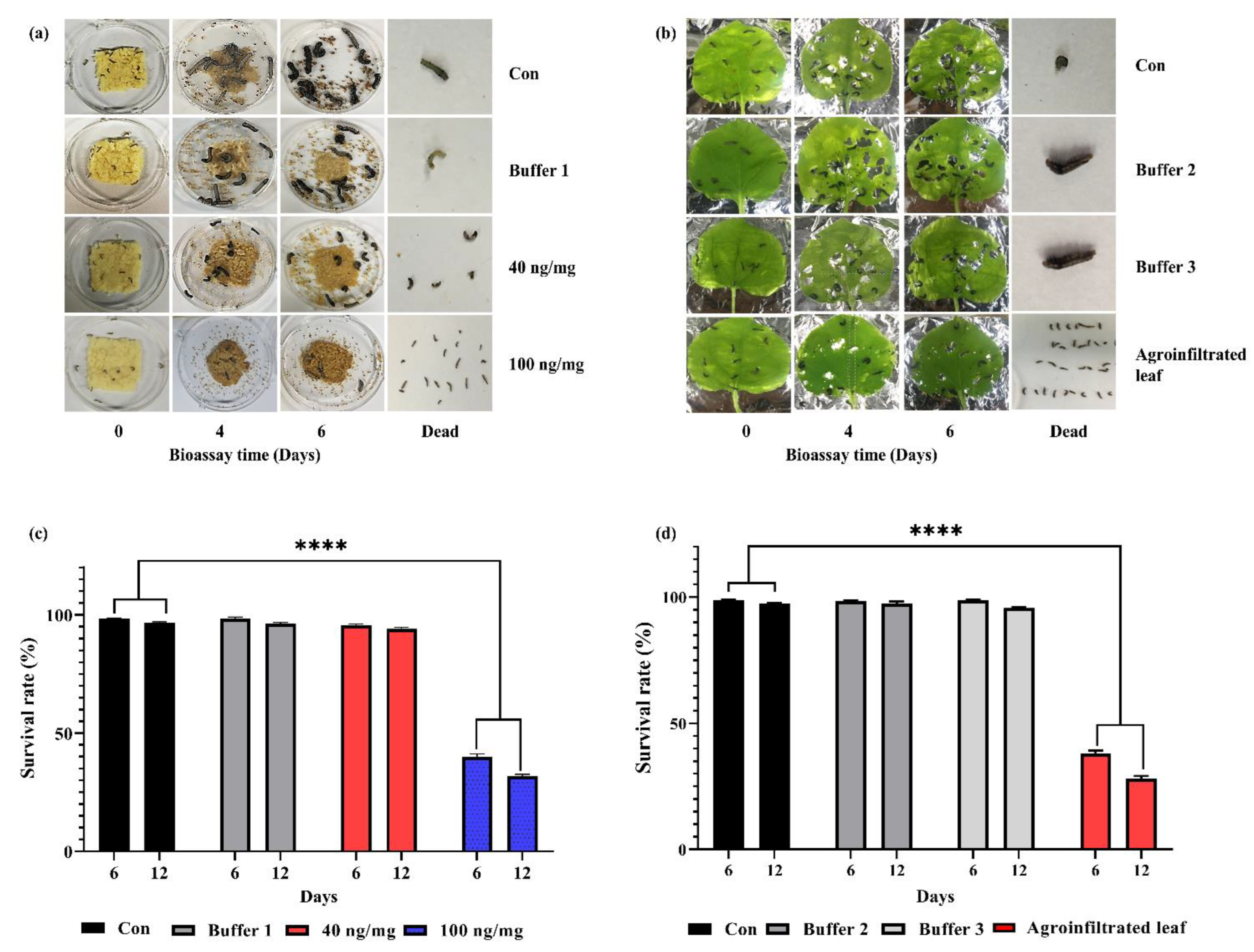
| Feed Type | Number of S. litura | LT50 ± SE (Day) | LT70 ± SE (Day) |
|---|---|---|---|
| Artificial diet (+Vip3Aa) | 100 | 5.8 ± 0.20 | 10.2 ± 0.41 |
| Agroinfiltrated leaf | 100 | 4.7 ± 0.45 | 9.2 ± 3.2 |
Publisher’s Note: MDPI stays neutral with regard to jurisdictional claims in published maps and institutional affiliations. |
© 2022 by the authors. Licensee MDPI, Basel, Switzerland. This article is an open access article distributed under the terms and conditions of the Creative Commons Attribution (CC BY) license (https://creativecommons.org/licenses/by/4.0/).
Share and Cite
Yoo, S.-H.; Jung, Y.J.; Lee, J.R. A New Approach for Environmental Risk Assessments of Living Modified Organisms in South Korea. Appl. Sci. 2022, 12, 4397. https://doi.org/10.3390/app12094397
Yoo S-H, Jung YJ, Lee JR. A New Approach for Environmental Risk Assessments of Living Modified Organisms in South Korea. Applied Sciences. 2022; 12(9):4397. https://doi.org/10.3390/app12094397
Chicago/Turabian StyleYoo, Su-Hyang, Young Jun Jung, and Jung Ro Lee. 2022. "A New Approach for Environmental Risk Assessments of Living Modified Organisms in South Korea" Applied Sciences 12, no. 9: 4397. https://doi.org/10.3390/app12094397
APA StyleYoo, S.-H., Jung, Y. J., & Lee, J. R. (2022). A New Approach for Environmental Risk Assessments of Living Modified Organisms in South Korea. Applied Sciences, 12(9), 4397. https://doi.org/10.3390/app12094397







